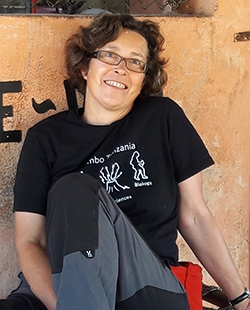TEAM
Dr. Paula García-Medrano
Researcher

Dr. Paula García Medrano, - Beatriu de Pinós - MSCA COFUND Fellowship at IPHES.
Broadly trained archaeologist, but specialised on Middle Pleistocene industries. Combining technological analysis with cutting-edge 3D imaging technology and Geometric Morphometrics, my main research interests are focused on the study of the Acheulean industries, analysing from shaping strategies to shapes variability, to understand the human occupation Western Europe.
Originally from Valladolid, my education includes a Bachelors' degree in History (2002) and a Master of Quaternary (2003) at the Rovira i Virgili University, Tarragona. I got a pre-doctoral grant funded by the Fundación Siglo para las Artes de Castilla y León, defending my PhD at the Burgos University in 2011. It was focused on the characterization of the Middle Pleistocene Technological systems on the Western Europe comparing Atapuerca (Galería and Gran Dolina-TD10.1) with Boxgrove (Quarry 1B). During this time, I got two Mobility Scholarships led me to make short research stays in two British Institutions: University College of London and British Museum.
The Archaeological sites of Atapuerca have been crucial on my career, being an active member of its research team since 1999. I have been directly involved in the management of excavations at Galería and Covacha de los Zarpazos sites from 2002 until now. These fieldwork responsibilities helped me during my professional activities as a completion of commercial archaeology partially out of Academia, and completing my knowledge of the Cultural Heritage on Prehistory research cycle.
After a period of maternity leave in 2015, I turned back to the Academia. Thanks to my previous established international network focused on the European Acheulean, in 2017 I got a Marie Skłodowska Curie Fellowship (IF Project ID: 748316), supervised by Dr. Nick Ashton at the British Museum (London, UK). This project led me to develop a new methodology combining the most traditional analysis with the use of 3D models, geometric morphometrics and other statistics and computational approaches, which improve my skills on these fields. The application of this method on 10 sites along UK, France and Spain, led me to gain a regional perspective of the Middle Pleistocene technology. During this time I was intensively working on an international network including British Museum, but also University College of London, Natural History Museum, Bradford University (UK), CNRS-UMR 7194 (MNHN, FR), Senckenberg Institute (GER), CENIEH and IPHES (ESP), crucial on my carreer.
In 2019, I obtained a one-year post-doctoral contract at the Muséum national d'Histoire naturelle UMR 7194 Paris (France) in the frame of the NEANDROOTS project (ANR-19-CE27-0011), funded by the Agence Nationale de la Recherche (ANR). I was working on the creation of a detailed database on MIS11 sites from Western and Central Europe.
Supervisor

Dr. Andreu Ollé is a researcher at IPHES (Institut Català de Paleoecologia Humana i Evolució Social) and an associate lecturer at Universitat Rovira i Virgili (Tarragona, Spain). His particular interests are the Early Palaeolithic stone tools (raw materials, knapping processes, Oldowan and Acheulean assemblages), the function of stone tools (microwear and residues analyses, experimental archaeology), the general application of microscopic studies to archaeological materials, and how all that can help to improve our knowledge on the early human settlement of Europe.
He has been a member of the Atapuerca Research Team since 1990, specializing in Palaeolithic Lithic Technology and Microwear analysis. He is currently sharing the coordination of the Gran Dolina site fieldwork in Atapuerca (Burgos, Spain). Other main ongoing projects are focused on the early human settlement in the Tarragona region (Spain), the Middle-Upper Palaeolithic transition in the Khorramabad valley (Iran), and the monitoring and quantification of tool microwear through advanced microscopic techniques.
Co-Partner

Dr. Marie-Hélène Moncel is a director of research at the CNRS - UMR 7194 (Department of Prehistory, Muséum National d'Histoire Naturelle, Paris, France). She is a specialist of hominin behaviors, in particular technology and land use patterns, from the earliest occupations in Europe to Neanderthal occupations. She has directed several international research and field programs, including the recent programs focusing on Acheulean and Homo heidelbergensis behavior in Europe between 700 and 500 ka. She has had the opportunity to excavate la Noira (the earliest known Acheulean French site), the famous Abbeville sites (Carpentier, Leon and Moulin Quignon quarries) in France and has been working for several years in Italy on the famous localities of the Ceprano basin. She is now the director of excavations at the site of Notarchirico in Italy. She is the author of 275 papers, including 170 papers in ISI-indexed peer-reviewed journals. She has also contributed to exhibitions at the National Natural History Museum, as well as in other French and foreign museums dedicated to Prehistory and the Palaeolithic. She belongs to an Erasmus Mundus "Prehistory and Quaternary" network and used to give lectures and supervise Master's and PhD students at the Universities of Ferrara in Italy and Tarragona in Spain.
Dr. Nick Ashton
Co-Partner

Dr. Nick Ashton has been a curator at the British Museum for 30 years, specializing in Lower and Middle Palaeolithic archaeology and helps curate the extensive stone tool collections from these periods. He has directed and published major excavation projects at the Lower Palaeolithic sites of High Lodge, Barnham, Elveden, Hoxne (all Suffolk) and Happisburgh (Norfolk).
From 2001-2013 he was Deputy Director of the Ancient Human Occupation of Britain Project (AHOB) funded by the Leverhulme Trust. This project with colleagues from the Natural History Museum, UCL, QMUL, RHUL, Oxford, Cambridge and York, has been examining the presence and habitat preferences of early humans in north-west Europe over the last 800,000 years. This work is now being continued with funding from the Calleva Foundation for The Pathways into Ancient Britain Project.
Dr. Jesús Rodríguez
Co-Partner

Dr. Jesús Rodrígez Ph.D. in Biology and specialist in the palaeoecology of European Pleistocene mammals, with an special interest in the interaction between palaeoecology and human evolution. Dr. Rodriguez participated in the Atapuerca Research Team during 25 years, he also conducted field work in Uruguay and he is the co-director of the field work at the Cueva de Guantes sites (Palencia, Spain). His research interest focused initially on the evolution of mammalian community structure, the influence of climate change on the extinction of megafauna and the influence of climatic and historical factors on the composition of recent faunas. Eventually, he also focused on the study of the trophic ecology of mammalian palaeocommunities and human-carnivore interactions using mathematical models. Dr. Rodriguez collaborates with the Palaeophisyology and Human Ecology Group at CENIEH in the study of Human Ecology in Pleistocene Europe
Christine Hertler
Co-Partner

Dr. Christine Hertler is palaeobiologist in the research center "The role
of culture in early expansions of humans (ROCEEH)" funded by the
Heidelberg Academy of
Sciences and Humanities. Christine Hertler is
based at the Senckenberg Research Institute (Frankfurt am Main,
Germany). In her studies
she focuses on the palaeoecology of Pleistocene macromammals including hominins. Christine
Hertler completed her
phD in biology with a thesis on morphological methods in evolution theory in 2000.
In her thesis she focused on application and development
of strict methodologies in conceptual modeling. She tested newly developed methods and procedures in an interdisciplinary research group which studied links between
population dynamics and resource supply of both, present and prehistoric human populations. Since 2008 she is
reconstructing palaeoenvironments of Pleistocene hominins in Africa and Eurasia and studies their palaeoecology.

